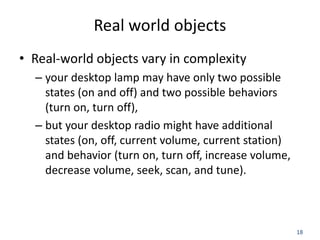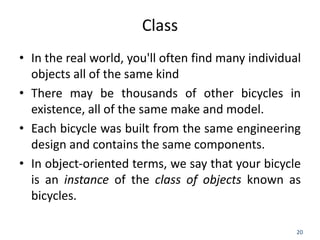Ad
lecture_for programming and computing basics
- 1. 1 CSC241: Object Oriented Programming Lecture No 01
- 2. 2 Aim of the course • This course provides – motivation of object oriented programming language – in depth knowledge of the various concepts of object oriented programming and its implementation in C++
- 3. 3 Course book • Text book – C++ How to program by Deitel and Deitel • Reference books – Waite Group’s Object oriented programming in C++, Robert Lafore
- 4. 4 Course outline Classes, Objects, Member functions, Objects as data types, Constructors and destructors, Overloaded constructor The default copy constructor, Returning objects from functions, objects and memory, Static class data, Constant member functions, Constant objects Base classes and derived classes, Derived class constructors, Overloading member functions, Scope resolution, Abstract classes, Public and private inheritance, Levels of inheritance, Multiple inheritance, Aggregation and composition New and delete operators, Pointers to objects, Virtual functions and late binding, Abstract classes and pure virtual functions, Virtual destructors, Virtual base classes, Friend functions and friend classes, Static functions, this pointer, Dynamic type information Motivation for exception handling, Try-catch block, Throwing an exception, Catching multiple exceptions Streams and files, Templates
- 5. 5 Marks distribution • Assignments: 10% • Quizzes: 15% • Sessional exam 01: 10% • Sessional exam 02: 15% • Terminal Exam: 50%
- 6. 6 Introduction • Five concepts in object oriented programming are: – Object – Classes – Encapsulation – Inheritance – Polymorphism
- 7. 7 Simple analogy • You are driving a car • You can pressing accelerator pedal • Someone has design it and built it • Engineering drawings car • Drawings also includes design for accelerator pedal to make car go faster • We can say, pedal “hides” complex mechanism that make the car go faster
- 8. 8 Cont. • Brake pedal “hides” the mechanism that slow the car • Steering wheel “hides” the mechanism that turn the car and so on • Simple “interfaces” like accelerator and brake pedal, steering wheel, transmission shift and etc. allow driver to interact car’s complex internal mechanisms
- 9. 9 Points to be noted • You cannot drive the engineering design of a car • Before you can drive a car, it must be built according to engineering design • The car will not accelerator on its own, a driver must press the accelerator pedal
- 10. 10 Object oriented programming concepts • Function hides from user the complex task it performs • Same as accelerator pedal hides complex mechanism of making the car go faster • C++ makes a program unit called class that houses various functions • Same as car engineering design houses the mechanism of accelerator pedal
- 11. 11 Cont. • In C++, a class can have various functions that are design to perform a class tasks • For example, a class representing bank account might contain functions – Deposit money – Withdraw money – Current balance
- 12. 12 Car example Real world • Engineering drawing cannot be drive • A car is build from that drawing • Pressing accelerator pedal sends a message to car to perform task (go faster) C++ programming • An object of a class must be create to get a program to perform the tasks the class describes • Message can be sent to object by calling a member functions
- 13. 13 Cont. • Car analogy is used to introduce – Class – Objects – Member functions • In addition to capabilities of car, it has many attributes • Color, No. of doors, amount of gas in tank, total miles driven and etc • Attributes are part of car engineering drawing
- 14. 14 Cont. • These attribute are always associated with the car • Every car maintains its own attribute • Example 1: each car knows how much gas in its own tank but do not know how much is in the tanks of other cars • Example 2: a bank account object has a balance attribute. Each bank account object knows the balance in its account not the others
- 15. 15 Object • Look around right now and you'll find many examples of real-world objects: • your dog, your desk, your television set, your bicycle. • Real-world objects share two characteristics: They all have – State and – Behavior
- 16. 16 Object example • A dog x has state (name, color, breed, hungry) and behavior (barking, fetching, wagging tail). • Your bicycle also have state (current gear, current pedal cadence, current speed) and behavior (changing gear, changing pedal cadence, applying brakes).
- 17. 17 Cont. • For each object that you see, ask yourself two questions: – "What possible states can this object be in?" and – "What possible behavior can this object perform?"
- 18. 18 Real world objects • Real-world objects vary in complexity – your desktop lamp may have only two possible states (on and off) and two possible behaviors (turn on, turn off), – but your desktop radio might have additional states (on, off, current volume, current station) and behavior (turn on, turn off, increase volume, decrease volume, seek, scan, and tune).
- 19. 19 Cont.. • You may also notice that some objects, in turn, will also contain other objects. • These real-world observations all translate into the world of object-oriented programming
- 20. 20 Class • In the real world, you'll often find many individual objects all of the same kind • There may be thousands of other bicycles in existence, all of the same make and model. • Each bicycle was built from the same engineering design and contains the same components. • In object-oriented terms, we say that your bicycle is an instance of the class of objects known as bicycles.
- 21. 21 Software Object • Software objects are conceptually similar to real-world objects: they too consist of state and related behavior. An object stores its state in – fields (variables in some programming languages) and exposes its behavior through – methods (functions in some programming languages). A Software Object
- 22. 22 Cont. • Methods operate on an object's internal state and serve as the primary mechanism for object-to-object communication.
- 23. 23 Class vs. Object • Class is a blue print of an object, which is non- live entity. • Object is instance of class, which is a live entity. • Example: – Employee is a class – Fruit is a class – I am an object – apple is an object
- 24. 24 Points to remember • A class is not a living entity, it is just a engineering design that how an object of this class look like • Object are living entities
- 25. 25 Defining a class with member function
- 26. 26 Cont. • Class definition • Access specifier – Public • Class’s body is enclosed in a pair of { } • Class definition ends at semi colon • Member function • Class object • Dot operator
- 27. 27 Member function with parameter Write a program
- 28. 28 #include <iostream.h> #include <string.h> class book{ private: char name[25]; int pages; float price; public: void changeName(char *n){ strcpy(name, n); } void changePages(int p){ pages = p; } void changePrice(float p){ price = p; } void display(){ cout<<"name = "<<name<<" pages = "<<pages<<" price = "<<price<<endl; } }; Book Class Simple program
- 29. 29 Class data • The class book contain three data items – char name[15]; – int pages; – float price; • There can be any number of data members in a class just as in structure • There data member lie under keyword private, so they can be accessed from within the class, but not outside
- 30. 30 Member function • These functions are included in a class • There are four member functions in class book – changeName(char *n) – changePages(int p) – changePrice(float p) – display() • There functions are followed by a keyword public, so they can be accessed outside the class
- 31. 31 Class data and member function • Access specifier label public and private • Function are public and data is private • Data is hidden so that it can be safe from accidental manipulation • Functions operates on data are public so they can be accessed from outside the class
- 32. 32 Defining Objects void main() { book b1; b1.changeName("Operating System"); b1.changePages(500); b1.changePrice(150.56); b1.display(); } Name Pages Price b1 Operating system 500 150.56
- 33. 33 Cont. • Defining an object is similar to defining a variable of any data type: Space is set aside for it in memory e.g. int x; • Defining objects in this way (book b1;) means creating them, also called instantiating them • An object is an instance (that is, a specific example) of a class. Objects are sometimes called instance variables.
- 34. 34 Calling Member Functions • The next four statements in main() call the member function – b1.changeName("Operating System"); – b1.changePages(500); – b1.changePrice(150.56); – b1.display(); • don’t look like normal function calls • This syntax is used to call a member function that is associated with a specific object • It doesn’t make sense to say – changeName("Operating System"); because a member function is always called to act on a specific object, not on the class in general
- 35. 35 Cont. • To use a member function, the dot operator (the period) connects the object name and the member function. • The syntax is similar to the way we refer to structure members, but the parentheses signal that we’re executing a member function rather than referring to a data item. • The dot operator is also called the class member access operator.
- 36. 36 Data members, set and get functions
- 37. 37 Example program – Distance class • Data members – Feet – Inches • Member functions – void setdist(int ft, float in); – void getdist(); – void initialize(); – void showdist(); Go to program
- 38. 38 Constructors • The Distance example shows two ways that member functions can be used to give values to the data items in an object • It is convenient if an object can initialize itself when it’s first created, without requiring a separate call to a member function • Automatic initialization is carried out using a special member function called a constructor. • A constructor is a member function that is executed automatically whenever an object is created.
- 39. 39 A counter example • Data member – Count • Member function – Constructor – void inc_count() – int get_count() Go to program



























![28
#include <iostream.h>
#include <string.h>
class book{
private:
char name[25];
int pages;
float price;
public:
void changeName(char *n){
strcpy(name, n);
}
void changePages(int p){
pages = p;
}
void changePrice(float p){
price = p;
}
void display(){
cout<<"name = "<<name<<" pages = "<<pages<<" price = "<<price<<endl;
}
};
Book Class
Simple program](https://image.slidesharecdn.com/lecture1csc241-240502144121-fd7e2050/85/lecture_for-programming-and-computing-basics-28-320.jpg)
![29
Class data
• The class book contain three data items
– char name[15];
– int pages;
– float price;
• There can be any number of data members in
a class just as in structure
• There data member lie under keyword private,
so they can be accessed from within the class,
but not outside](https://image.slidesharecdn.com/lecture1csc241-240502144121-fd7e2050/85/lecture_for-programming-and-computing-basics-29-320.jpg)

































































